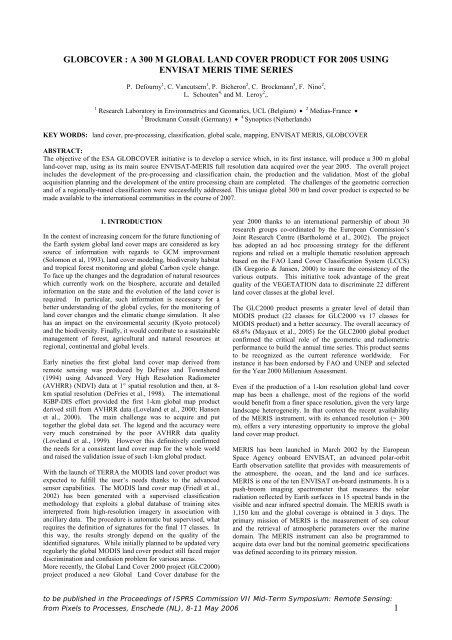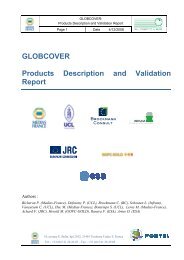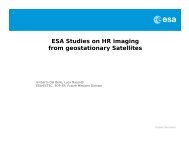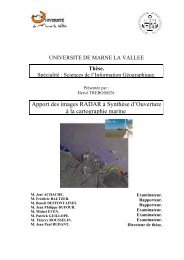a 300 m global land cover product for 2005 using envisat meris time
a 300 m global land cover product for 2005 using envisat meris time
a 300 m global land cover product for 2005 using envisat meris time
You also want an ePaper? Increase the reach of your titles
YUMPU automatically turns print PDFs into web optimized ePapers that Google loves.
GLOBCOVER : A <strong>300</strong> M GLOBAL LAND COVER PRODUCT FOR <strong>2005</strong> USING<br />
ENVISAT MERIS TIME SERIES<br />
P. Defourny 1 , C. Vancutsem 1 , P. Bicheron 2 , C. Brockmann 3 , F. Nino 2 ,<br />
L. Schouten 4, and M. Leroy 2 ,.<br />
1 Research Laboratory in Environmetrics and Geomatics, UCL (Belgium) • 2 Medias-France •<br />
3<br />
Brockmann Consult (Germany) • 4 Synoptics (Nether<strong>land</strong>s)<br />
KEY WORDS: <strong>land</strong> <strong>cover</strong>, pre-processing, classification, <strong>global</strong> scale, mapping, ENVISAT MERIS, GLOBCOVER<br />
ABSTRACT:<br />
The objective of the ESA GLOBCOVER initiative is to develop a service which, in its first instance, will produce a <strong>300</strong> m <strong>global</strong><br />
<strong>land</strong>-<strong>cover</strong> map, <strong>using</strong> as its main source ENVISAT-MERIS full resolution data acquired over the year <strong>2005</strong>. The overall project<br />
includes the development of the pre-processing and classification chain, the <strong>product</strong>ion and the validation. Most of the <strong>global</strong><br />
acquisition planning and the development of the entire processing chain are completed. The challenges of the geometric correction<br />
and of a regionally-tuned classification were successfully addressed. This unique <strong>global</strong> <strong>300</strong> m <strong>land</strong> <strong>cover</strong> <strong>product</strong> is expected to be<br />
made available to the international communities in the course of 2007.<br />
1. INTRODUCTION<br />
In the context of increasing concern <strong>for</strong> the future functioning of<br />
the Earth system <strong>global</strong> <strong>land</strong> <strong>cover</strong> maps are considered as key<br />
source of in<strong>for</strong>mation with regards to GCM improvement<br />
(Solomon et al, 1993), <strong>land</strong> <strong>cover</strong> modeling, biodiversity habitat<br />
and tropical <strong>for</strong>est monitoring and <strong>global</strong> Carbon cycle change.<br />
To face up the changes and the degradation of natural resources<br />
which currently work on the biosphere, accurate and detailed<br />
in<strong>for</strong>mation on the state and the evolution of the <strong>land</strong> <strong>cover</strong> is<br />
required. In particular, such in<strong>for</strong>mation is necessary <strong>for</strong> a<br />
better understanding of the <strong>global</strong> cycles, <strong>for</strong> the monitoring of<br />
<strong>land</strong> <strong>cover</strong> changes and the climatic change simulation. It also<br />
has an impact on the environmental security (Kyoto protocol)<br />
and the biodiversity. Finally, it would contribute to a sustainable<br />
management of <strong>for</strong>est, agricultural and natural resources at<br />
regional, continental and <strong>global</strong> levels.<br />
Early nineties the first <strong>global</strong> <strong>land</strong> <strong>cover</strong> map derived from<br />
remote sensing was produced by DeFries and Townshend<br />
(1994) <strong>using</strong> Advanced Very High Resolution Radiometer<br />
(AVHRR) (NDVI) data at 1° spatial resolution and then, at 8-<br />
km spatial resolution (DeFries et al., 1998). The international<br />
IGBP-DIS ef<strong>for</strong>t provided the first 1-km <strong>global</strong> map <strong>product</strong><br />
derived still from AVHRR data (Love<strong>land</strong> et al., 2000; Hansen<br />
et al., 2000). The main challenge was to acquire and put<br />
together the <strong>global</strong> data set. The legend and the accuracy were<br />
very much constrained by the poor AVHRR data quality<br />
(Love<strong>land</strong> et al., 1999). However this definitively confirmed<br />
the needs <strong>for</strong> a consistent <strong>land</strong> <strong>cover</strong> map <strong>for</strong> the whole world<br />
and raised the validation issue of such 1-km <strong>global</strong> <strong>product</strong>.<br />
With the launch of TERRA the MODIS <strong>land</strong> <strong>cover</strong> <strong>product</strong> was<br />
expected to fulfill the user’s needs thanks to the advanced<br />
sensor capabilities. The MODIS <strong>land</strong> <strong>cover</strong> map (Friedl et al.,<br />
2002) has been generated with a supervised classification<br />
methodology that exploits a <strong>global</strong> database of training sites<br />
interpreted from high-resolution imagery in association with<br />
ancillary data. The procedure is automatic but supervised, what<br />
requires the definition of signatures <strong>for</strong> the final 17 classes. In<br />
this way, the results strongly depend on the quality of the<br />
identified signatures. While initially planned to be updated very<br />
regularly the <strong>global</strong> MODIS <strong>land</strong> <strong>cover</strong> <strong>product</strong> still faced major<br />
discrimination and confusion problem <strong>for</strong> various areas.<br />
More recently, the Global Land Cover 2000 project (GLC2000)<br />
project produced a new Global Land Cover database <strong>for</strong> the<br />
year 2000 thanks to an international partnership of about 30<br />
research groups co-ordinated by the European Commission’s<br />
Joint Research Centre (Bartholomé et al., 2002). The project<br />
has adopted an ad hoc processing strategy <strong>for</strong> the different<br />
regions and relied on a multiple thematic resolution approach<br />
based on the FAO Land Cover Classification System (LCCS)<br />
(Di Gregorio & Jansen, 2000) to insure the consistency of the<br />
various outputs. This initiative took advantage of the great<br />
quality of the VEGETATION data to discriminate 22 different<br />
<strong>land</strong> <strong>cover</strong> classes at the <strong>global</strong> level.<br />
The GLC2000 <strong>product</strong> presents a greater level of detail than<br />
MODIS <strong>product</strong> (22 classes <strong>for</strong> GLC2000 vs 17 classes <strong>for</strong><br />
MODIS <strong>product</strong>) and a better accuracy. The overall accuracy of<br />
68.6% (Mayaux et al., <strong>2005</strong>) <strong>for</strong> the GLC2000 <strong>global</strong> <strong>product</strong><br />
confirmed the critical role of the geometric and radiometric<br />
per<strong>for</strong>mance to build the annual <strong>time</strong> series. This <strong>product</strong> seems<br />
to be recognized as the current reference worldwide. For<br />
instance it has been endorsed by FAO and UNEP and selected<br />
<strong>for</strong> the Year 2000 Millenium Assessment.<br />
Even if the <strong>product</strong>ion of a 1-km resolution <strong>global</strong> <strong>land</strong> <strong>cover</strong><br />
map has been a challenge, most of the regions of the world<br />
would benefit from a finer space resolution, given the very large<br />
<strong>land</strong>scape heterogeneity. In that context the recent availability<br />
of the MERIS instrument, with its enhanced resolution (~ <strong>300</strong><br />
m), offers a very interesting opportunity to improve the <strong>global</strong><br />
<strong>land</strong> <strong>cover</strong> map <strong>product</strong>.<br />
MERIS has been launched in March 2002 by the European<br />
Space Agency onboard ENVISAT, an advanced polar-orbit<br />
Earth observation satellite that provides with measurements of<br />
the atmosphere, the ocean, and the <strong>land</strong> and ice surfaces.<br />
MERIS is one of the ten ENVISAT on-board instruments. It is a<br />
push-broom imaging spectrometer that measures the solar<br />
radiation reflected by Earth surfaces in 15 spectral bands in the<br />
visible and near infrared spectral domain. The MERIS swath is<br />
1,150 km and the <strong>global</strong> <strong>cover</strong>age is obtained in 3 days. The<br />
primary mission of MERIS is the measurement of sea colour<br />
and the retrieval of atmospheric parameters over the marine<br />
domain. The MERIS instrument can also be programmed to<br />
acquire data over <strong>land</strong> but the nominal geometric specifications<br />
was defined according to its primary mission.<br />
to be published in the Proceedings of ISPRS Commission VII Mid-Term Symposium: Remote Sensing:<br />
from Pixels to Processes, Enschede (NL), 8-11 May 2006 1
2. OBJECTIVES<br />
In that context, the objective of the GLOBCOVER project is to<br />
develop and demonstrate a service that will produce a <strong>global</strong><br />
<strong>land</strong> <strong>cover</strong> map <strong>for</strong> the year <strong>2005</strong>, <strong>using</strong> as main source of data<br />
the fine resolution (<strong>300</strong>m) mode data from MERIS to be<br />
acquired over the full year <strong>2005</strong>. The thematic legend of the<br />
final <strong>product</strong> is intended to be compatible with the FAO LCCS<br />
used <strong>for</strong> the GLC 2000 map. The development is conceived<br />
such that the new <strong>product</strong> will update and complement the other<br />
existing comparable <strong>global</strong> <strong>product</strong>s, in particular the <strong>global</strong><br />
<strong>land</strong> <strong>cover</strong> map at 1 km resolution <strong>for</strong> the year 2000 (GLC-<br />
2000) produced by the JRC. It is also expected to improve such<br />
previous <strong>global</strong> <strong>product</strong>s, in particular through a finer resolution<br />
(<strong>300</strong>m).<br />
The GLOBCOVER aims not only to produce a <strong>global</strong> <strong>300</strong> m<br />
<strong>land</strong> <strong>cover</strong> map <strong>for</strong> the year <strong>2005</strong> but also to develop a software<br />
system made of two components, a first component dealing<br />
with the data pre-processing and a second component providing<br />
an automatic classifier, including the trans<strong>for</strong>mation of<br />
composites of surface reflectance into classes satisfying the<br />
LCCS nomenclature. Finally, the system and the <strong>product</strong>s have<br />
to undergo a validation exercise, in order to reach the<br />
international standards in terms of geophysical quality.<br />
3. GLOBCOVER CHALLENGES<br />
This challenging project can only be <strong>for</strong>eseen because of the<br />
combination of various experiences previously acquired..<br />
Indeed, from a thematic point of view, the experience gained in<br />
the GLC2000 appeared to be really mandatory to properly<br />
understand the GLOBCOVER issue and to tackle the main<br />
problem related to the <strong>product</strong>ion of a consistent <strong>land</strong> <strong>cover</strong> map<br />
at the <strong>global</strong> scale while the <strong>land</strong> <strong>cover</strong> reality is made of<br />
diversity, ambiguity and continuum.<br />
Five main challenging areas are identified <strong>for</strong> the<br />
GLOBCOVER project:<br />
(i) the data acquisition planning to insure the high temporal<br />
resolution of this <strong>global</strong> <strong>300</strong> m <strong>time</strong> series with 15 spectral<br />
bands;<br />
(ii) the high standards pre-processing chain requires to produce<br />
consistent MERIS <strong>time</strong> series at <strong>300</strong>m resolution. This includes:<br />
ortho-rectification of MERIS Level 1b <strong>product</strong>s <strong>using</strong><br />
AMORGOS tool, a <strong>land</strong>/sea classification <strong>using</strong> MERIS<br />
measurements instead of the static-<strong>land</strong> sea mask because of the<br />
<strong>300</strong> m resolution, a spectral normalisation of the bands most<br />
affected by the smile effect to the reference wavelength, an<br />
efficient cloud screening in the absence of SWIR and Thermal<br />
bands, a good compositing strategy to correct the BRDF effect<br />
and make use of most of the in<strong>for</strong>mation available as the<br />
acquisitions are far from daily.<br />
(iii) the handling and the processing of such a very large volume<br />
of data. The system is required to handle big data volumes in a<br />
short <strong>time</strong> span : the MERIS raw data volume is over 16<br />
Terabytes, corresponding to 16 months of MERIS full<br />
resolution and full swath data from the 1st December 2004 to<br />
the 31st March 2006 between 85°N and 56°S, excluding ocean<br />
areas. This input data has to be fed into the pre-processing line.<br />
Besides the technical means necessary to physically transmit<br />
these data to the appropriate recipient, this implies a high level<br />
of collaboration between all the steps of the complete<br />
processing line. Dataflow can also become a bottleneck if data<br />
is not transmitted quickly enough from its repository to the<br />
required process.<br />
(iv) the regionally-tuned <strong>land</strong> <strong>cover</strong> classification to be<br />
automatic, <strong>global</strong> and maintaining the <strong>300</strong>-m resolution through<br />
the whole process. The <strong>global</strong> scale of this mapping exercise<br />
<strong>for</strong>ces to encompass the whole diversity of <strong>land</strong> <strong>cover</strong> types<br />
while the temporal dimension of the data analysis requires an<br />
in-depth understanding of the related seasonality <strong>for</strong> the<br />
different bioclimatic regions. The key idea is to combine the<br />
spatial consistency of the classes delineation obtained from well<br />
selected multispectral composites with the discrimination power<br />
of the temporal profiles analysis. Be<strong>for</strong>e that, an a priori<br />
stratification of the world provides equal-reasoning regions to<br />
be processed separately. The great but much controlled<br />
flexibility of this classification strategy allowed defining an<br />
automatic process tackling both the regional diversity and the<br />
local heterogeneity of the <strong>land</strong> <strong>cover</strong> characteristics;<br />
(v) the validation of the GLOBCOVER <strong>product</strong> to be completed<br />
in the course of this 2-year project. However, this can not af<strong>for</strong>d<br />
to collect primary sources of in<strong>for</strong>mation at <strong>global</strong> scale while<br />
relevant use of the GLOBCOVER map requires a detaited<br />
documentation on the geometric and thematic accuracies of the<br />
<strong>product</strong>.<br />
4. OVERALL APPROACH<br />
The overall project includes the development of the preprocessing<br />
and classification chain, the <strong>product</strong>ion and the<br />
validation. The figure shows an overview of the GLOBCOVER<br />
system.<br />
Level 1B<br />
MERIS<br />
LCCS Land<br />
Cover Map<br />
FR<br />
4.1 Pre-processing<br />
Figure 1. GLOBCOVER system overview<br />
The pre-processing includes the following steps: Geometric<br />
correction of the input data to achieve a geolocation accuracy of<br />
one third of pixel, cloud screening, <strong>land</strong>/water reclassification<br />
and a correction of the smile effect as a prerequisite <strong>for</strong> the<br />
subsequent atmospheric correction. The final BRDF correction<br />
and compositing step produces cloud-free syntheses.<br />
4.2 Stratification<br />
Pre-processing<br />
Preprocessing<br />
Corrections<br />
BRDF<br />
Geometric Cloud Atmospheric correction<br />
screening Corrections<br />
and<br />
compositing<br />
Validation<br />
Classification<br />
Labeling<br />
Spectr-<br />
temporal<br />
classifi<br />
cation<br />
Level 3<br />
MERIS<br />
Mosaics FR<br />
In order to deal with the diversity of ecological patterns at the<br />
<strong>global</strong> scale, the <strong>global</strong> stratification is a preliminary step to<br />
split the world in equal-reasoning areas from bioclimatic but<br />
also from a remote sensing point of view. This is the<br />
cornerstone <strong>for</strong> the regional tuning applied <strong>for</strong> all the<br />
to be published in the Proceedings of ISPRS Commission VII Mid-Term Symposium: Remote Sensing:<br />
from Pixels to Processes, Enschede (NL), 8-11 May 2006 2
consecutive classification steps as each region will be processed<br />
separately and mosaic into a single file afterwards. The areas<br />
have identified based on several criteria, including the<br />
vegetation seasonality, the snow <strong>cover</strong>, the burning period, the<br />
distribution of sun zenith angle, the cloud <strong>cover</strong>age and the data<br />
availability. On one hand, it reduces the <strong>land</strong> <strong>cover</strong> variability in<br />
the data set to process and so improve the discrimination<br />
efficiency of the classification algorithms. On the other hand,<br />
the classification parameters, i.e. temporal synthesis, specific<br />
band combinations, number of classes, etc, can be selected<br />
according to the characteristics of each equal-reasoning area.<br />
The stratification delineation was completed in way to avoid<br />
inducing artificial limits in the final <strong>land</strong> <strong>cover</strong> <strong>product</strong>. They<br />
are based on natural limits directly derived from sharp<br />
boundaries observed in any remote sensing data set or through<br />
easy-to-classified and homogeneous <strong>land</strong> <strong>cover</strong> area. The most<br />
obvious limits are oceans and seas. It is also easy to derive well<br />
contrasted limits between biomes present in the annual<br />
composite, e.g. the equatorial <strong>for</strong>est / savannah interface.<br />
4.3 Classification method<br />
The <strong>land</strong> <strong>cover</strong> classification aims at the trans<strong>for</strong>mation of the<br />
surface reflectance’s into a validated <strong>global</strong> <strong>land</strong> <strong>cover</strong> <strong>product</strong>.<br />
The overall classification per<strong>for</strong>mance relies on three steps:<br />
(i) a classification algorithm to define homogeneous <strong>land</strong> <strong>cover</strong><br />
objects based on one (or at most two) multispectral reflectance<br />
composite(s); (ii) a <strong>land</strong> <strong>cover</strong> discrimination algorithm made of<br />
iterative multidimensional clustering techniques;<br />
(iii) a labelling procedure built on reference classifications such<br />
as the GLC2000 regional <strong>product</strong>s and then adjusted to MERIS<br />
mapping capabilities with the support of international experts<br />
33:,4780,843,<br />
9<br />
&3,-00/<br />
!74/:.9<br />
.:89073<br />
3.,8808<br />
:89073<br />
.,8808<br />
'<br />
#<br />
4254890<br />
04 .,3308<br />
Figure 2. GLOBCOVER classification method.<br />
5. PRELIMINARY RESULTS<br />
!0344.,<br />
.,7,.9078,943<br />
9<br />
,.:,9320,341<br />
0,.3/.,947507<br />
.,88<br />
3<br />
,<br />
259<br />
59<br />
The <strong>time</strong> series actually acquired <strong>for</strong> the GLOBCOVER project<br />
provides a great <strong>cover</strong>age of the world but not yet uni<strong>for</strong>m as<br />
shown in the figure 3.<br />
As some areas have not been adequately <strong>cover</strong>ed during the<br />
nominal acquisition planning, the <strong>global</strong> MERIS FR acquisition<br />
has been further extended beyond March 2006 <strong>for</strong><br />
GLOBCOVER.<br />
The development of the GLOBCOVER pre-processing chain<br />
based on the AMORGOS module succeeded to reach the<br />
geometric accuracy required <strong>for</strong> <strong>time</strong> series analysis over <strong>land</strong>.<br />
For the relative accuracy, the analysis of 146 pairs of images<br />
widely distributed provided a RMSE value of 51,6 m. The<br />
absolute accuracy estimated from 10 Landsat-MERIS couples<br />
reached a RMSE value of 77 m.<br />
Figure 3. Current distribution of MERIS FR acquisition<br />
<strong>for</strong> the year <strong>2005</strong> (ESA) (from black to white according to the<br />
number of acquisition data).<br />
A <strong>global</strong> stratification was completed to split the world into 22<br />
equal-reasoning regions from bioclimatic, <strong>land</strong> <strong>cover</strong> and<br />
satellite observation conditions points of view. Very few limits<br />
were not obvious and required a particular attention. The<br />
figure 4 illustrates the GLOBCOVER stratification.<br />
Figure 4. GLOBCOVER stratification delineating 22 equalreasoning<br />
areas <strong>for</strong> the world.<br />
The preliminary classification tests completed <strong>for</strong> several<br />
subsets built the confidence in the classification concept. The<br />
nominal GLOBCOVER legend has been defined <strong>using</strong> the FAO<br />
LCCS . This hierarchical typology includes 24 plain <strong>land</strong> <strong>cover</strong><br />
classes and 38 classes when combined with bioclimatic zones.<br />
This was submitted to an international experts panel as well as<br />
to the <strong>land</strong> <strong>cover</strong> community. This <strong>land</strong> <strong>cover</strong> typology is also<br />
GLC2000 compatible in order to hopefully detect the change<br />
between 2000 and <strong>2005</strong>.<br />
Finally, a validation plan relying to an international network of<br />
regional <strong>land</strong> <strong>cover</strong> experts has been designed to validate<br />
independently the final <strong>land</strong> <strong>cover</strong> <strong>product</strong>. The experts will<br />
serve reference as they are supposed to provide the best<br />
in<strong>for</strong>mation available based on their own experiences, the<br />
examination of existing maps and the interpretation of any other<br />
remote sensing imagery.<br />
5. PERSPECTIVES<br />
Major steps of the GLOBCOVER initiative have been<br />
successfully passed, such as the building of a <strong>global</strong> MERIS FR<br />
data set and the significant improvement of the geometric<br />
accuracy of the MERIS data. The pre-processing chain is<br />
completed and the first tests of classification are going-on. The<br />
overall processing of this mass volume of raw data is not<br />
completed yet and the final validated <strong>land</strong> <strong>cover</strong> <strong>product</strong> is<br />
expected <strong>for</strong> June 2007.<br />
to be published in the Proceedings of ISPRS Commission VII Mid-Term Symposium: Remote Sensing:<br />
from Pixels to Processes, Enschede (NL), 8-11 May 2006 3
ACKNOWLEDGEMENTS<br />
The authors are grateful to ESA <strong>for</strong> his technical and financial<br />
support and to the GLOBCOVER community <strong>for</strong> the scientific<br />
advices, in particular to the EU JRC-GEM members, to the<br />
GOFC-GOLD office, to FAO-LCCS team, to USGS EDC and<br />
to the Space Research Institute of the Russian Academy of<br />
Science.<br />
REFERENCES<br />
Bartholomé, E., Belward, A.S., Achard, F., Bartalev, S.,<br />
Carmona Moreno, C., Eva, H., Fritz, S., Grégoire, J.-M.,<br />
Mayaux, P., and, Stibig, H-J., 2002, Global Land Cover<br />
mapping <strong>for</strong> the year 2000 – Project status November<br />
2002. Office <strong>for</strong> Official Publications of the European<br />
Communities, Luxembourg, EUR 20524.<br />
Cihlar, J. (2000). Land <strong>cover</strong> mapping of large areas from<br />
satellites: Status and research priorities. International<br />
Journal of Remote Sensing, 21, 1093– 1114.<br />
Chandra G., Defourny P., Shrestha A S., 2003. Land<br />
<strong>cover</strong> characterization and mapping of continental<br />
Southeast Asia <strong>using</strong> multi-resolution satellite Data.<br />
International Journal of Remote Sensing, vol. 24, n°21,<br />
4181-4196.<br />
DeFries, R. S., and Townshend, J. G. R., 1994, NDVI<br />
derived <strong>land</strong> <strong>cover</strong> classifications at a <strong>global</strong> scale.<br />
International Journal of Remote Sensing, 5, 3567– 3586.<br />
DeFries, R. S., Hansen, M., Townshend, J. R. G., &<br />
Sohlberg, R. (1998). Global <strong>land</strong> <strong>cover</strong> classification at 8<br />
km spatial resolution: Part 1. Training and validation data<br />
derived from Landsat imagery. International Journal of<br />
Remote Sensing, 19, 3141–3168.<br />
DeFries, R., Hansen, M., Townshend, J. R. G. and<br />
Sohlberg, R., 1998, Global <strong>land</strong> <strong>cover</strong> classifications at 8<br />
km spatial resolution: The use of training data derived<br />
from Landsat imagery in decision tree classifiers,<br />
International Journal of Remote Sensing; 19 (16): 3141-<br />
3168.<br />
Di Gregorio, A., & Jansen, L. J. M. (2000). Land <strong>cover</strong><br />
classification system (LCCS): Classification concepts and<br />
user manual. GCP/RAF/287/ITA Afri<strong>cover</strong>—East Africa<br />
Project and Soil Resources, Management and<br />
Conservation Service, Food and Agriculture<br />
Organization.<br />
Friedl, M.A., McIver, D.K., Hodges, J.C.F., Zhang, X.Y.,<br />
Muchoney, Strahler, A.H, Woodcock, C.E., Gopal, S.,<br />
Schneider, A., Cooper, A., Baccini, A., Gao, F., Schaaf,<br />
C., 2002, Global <strong>land</strong> <strong>cover</strong> mapping from MODIS:<br />
algorithms and early results, Remote Sensing of<br />
Environment, 83, 287–302.<br />
Hansen, M. C., Defries, R. S., Townshend, J. R. G., &<br />
Sohlberg, R., 2000, Global <strong>land</strong> <strong>cover</strong> classification at 1<br />
km spatial resolution <strong>using</strong> a classification tree approach.<br />
International Journal of Remote Sensing, 21, 1331–<br />
1364.<br />
JRC, 2003, The Global Land Cover 2000 Project (GLC-<br />
2000). available at:<br />
http://www.gvm.jrc.it/glc2000/defaultglc2000.<br />
Love<strong>land</strong>, T. R., Reed, B. C., Brown, J. F., Ohlen, D. O.,<br />
Zhu, Z., Yang, L., and Merchant, J. W., 2000,<br />
Development of a <strong>global</strong> <strong>land</strong> <strong>cover</strong> characteristics<br />
database and IGBP DISCover from 1 km AVHRR data.<br />
International Journal of Remote Sensing, 21(6–7), 1303–<br />
1365.<br />
Love<strong>land</strong>, T. R., Zhu, Z., Ohlen, D. O., Brown, J. F.,<br />
Reed, B. C., and Yang, L., 1999, An analysis of the IGBP<br />
<strong>global</strong> <strong>land</strong> <strong>cover</strong> characterization process.<br />
Photogrammetric Engineering and Remote Sensing, 65,<br />
1021– 1031.<br />
Mayaux P., Eva H., Gallego J., Strahler A., Herold M., Shefali<br />
A., Naumov S., De Miranda E., Di Bella C., Ordoyne C. and<br />
Kopin I., 2006. Validation of the Global Land Cover 2000 Map.<br />
IEEE Trans.Geosciences and Remote Sensing, 44 : 7, Part 1,<br />
1926- 1928.<br />
Pekel, J.-F., Defourny, P., 2001, GLC mapping in semiarid<br />
regions: a case study in West Africa, GLC 2000<br />
methods workshop Ispra (Italy).<br />
Pekel, J.-F., Vancutsem, C., Defourny, P., 2002, Mapping<br />
of the African Great Lakes region from daily<br />
VEGETATION data, GLC 2000 "first results" workshop<br />
- Ispra (Italy).<br />
Pekel, J.-F., Vancutsem, C., Defourny, P., 2003, Pan-<br />
European <strong>land</strong> <strong>cover</strong> map derived from 366 daily SPOT<br />
VEGETATION images, GLC 2000 "final results"<br />
workshop - Ispra (Italy).<br />
Solomon A.M., Shugart H.H., (1993), Vegetation<br />
Dynamics & Global Change, Chapman & Hall.<br />
Vancutsem, C., Pekel, J.-F., Bogaert, P., and Defourny,<br />
P., 2006, Mean Compositing, an alternative strategy <strong>for</strong><br />
producing temporal syntheses. Concepts and per<strong>for</strong>mance<br />
assessment <strong>for</strong> SPOT VEGETATION <strong>time</strong> series,<br />
International Journal of Remote Sensing, (in press).<br />
to be published in the Proceedings of ISPRS Commission VII Mid-Term Symposium: Remote Sensing:<br />
from Pixels to Processes, Enschede (NL), 8-11 May 2006 4








